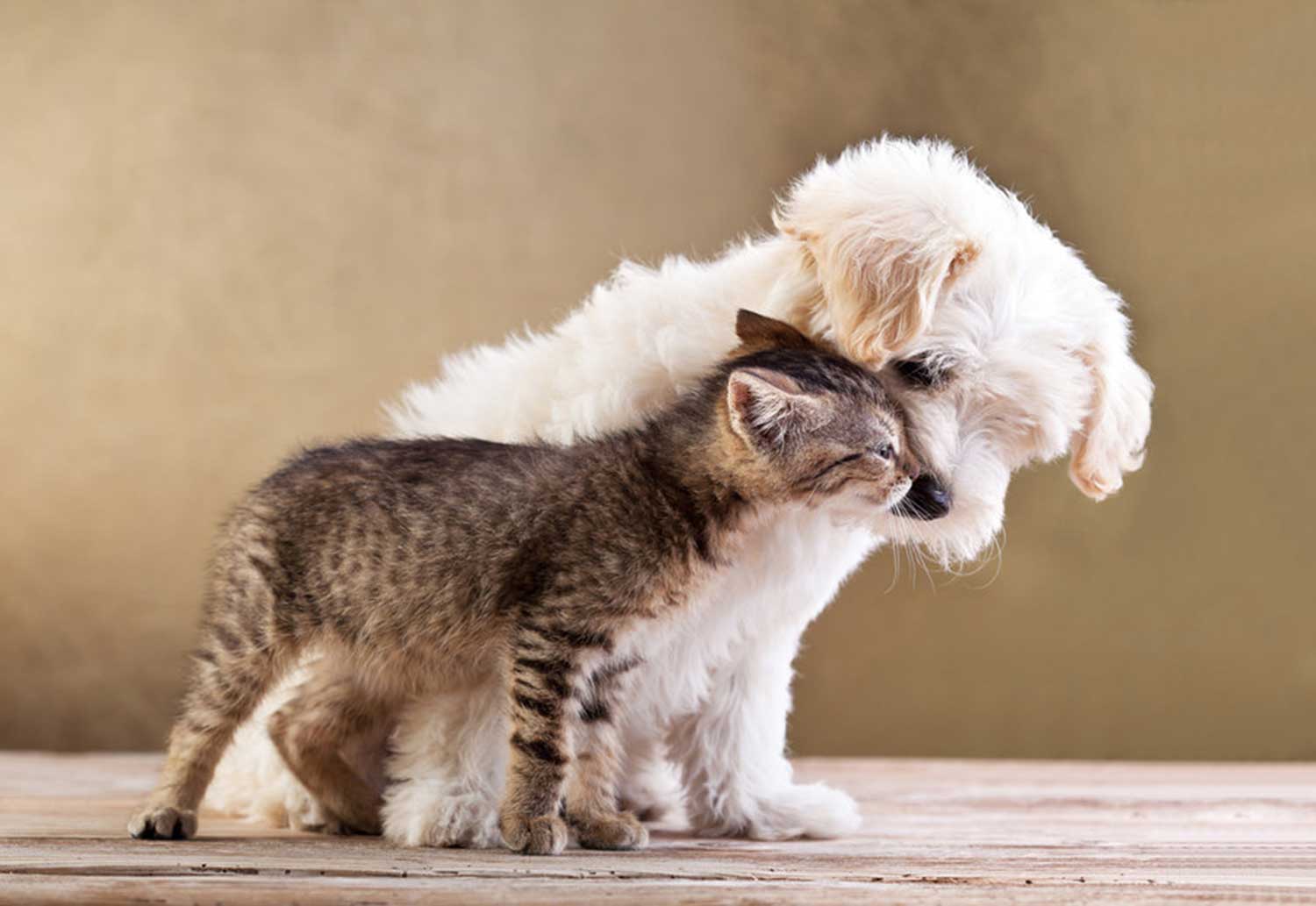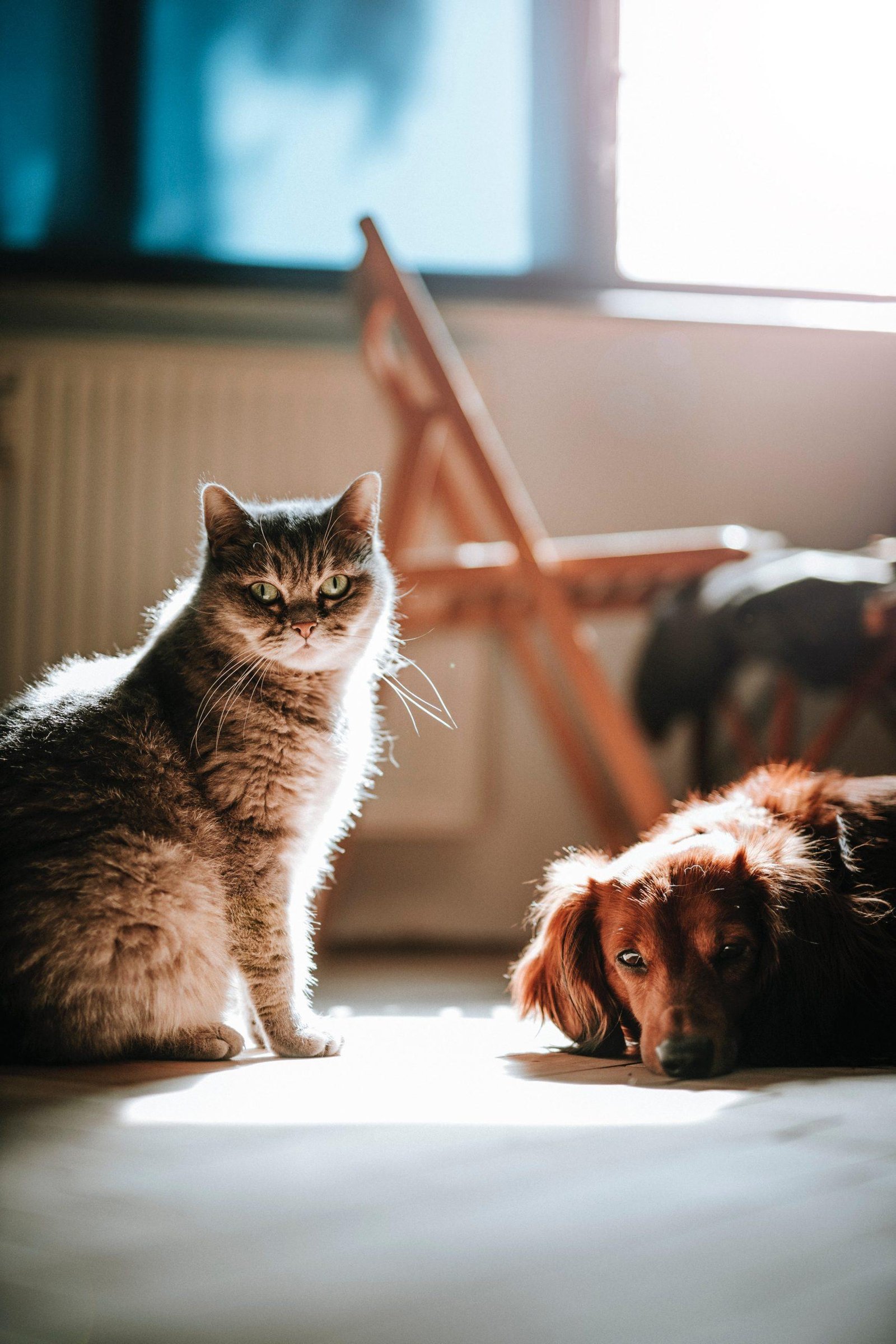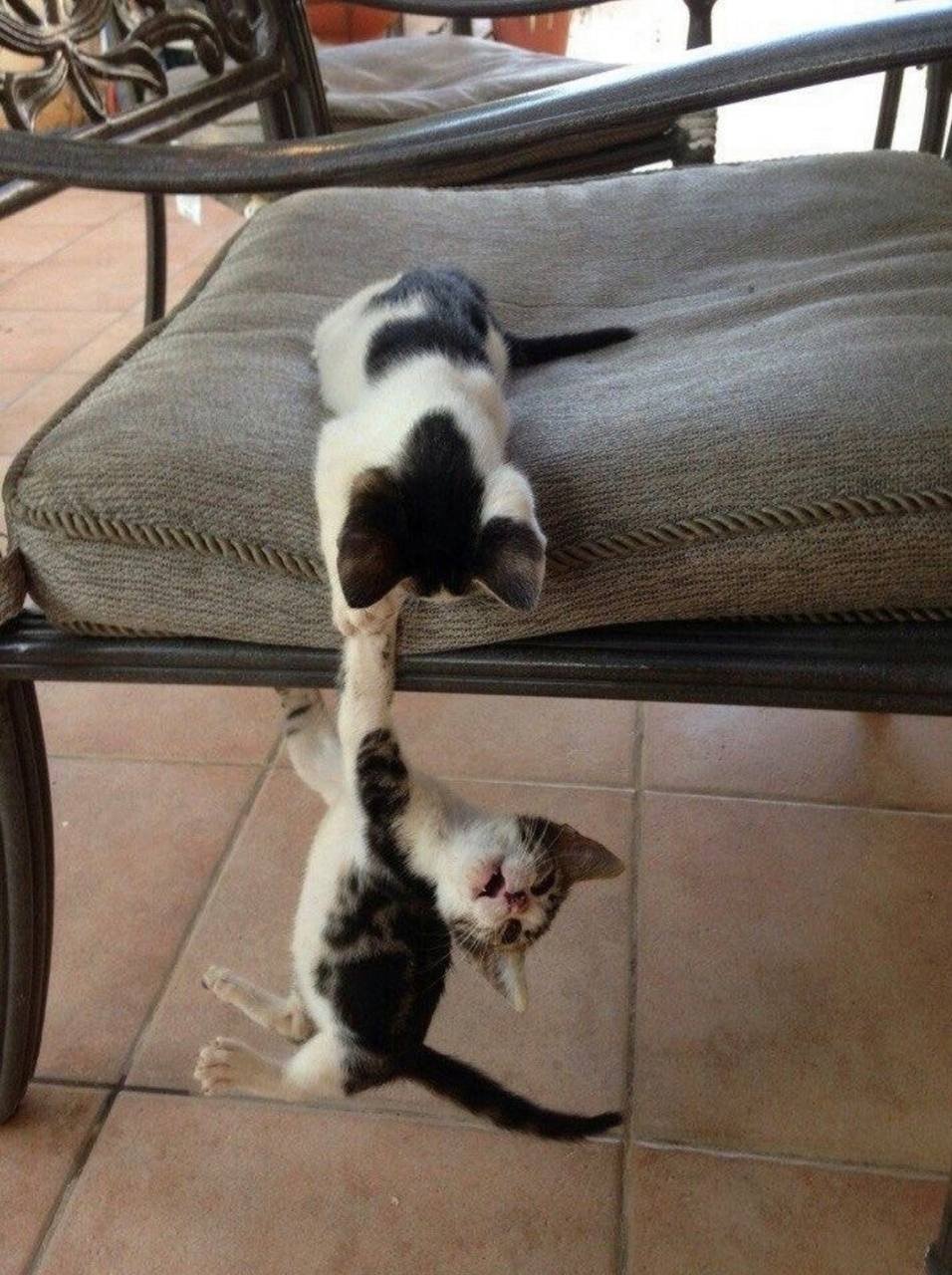Views: 90

Do you have your heart set on being the proud owner of both a cat and a dog? Cats and dogs can and do happily share their lives together in the same household, but establishing a safe environment for both can be a challenge.
There is something inherently appealing about inter-species friendship. The thought of Fido and Kitty being best friends – despite their stereotypical animosity – is heartwarming. If this is something you’d like to achieve too, then you’re probably wondering what would be the best way to introduce a dog to your resident cat, or perhaps the other way around. Read on to see if and how you can achieve this.
Note: We may get commissions for purchases made through links on this page.
Should you introduce a cat and a dog?
Table of Contents
Introducing pets is stressful for all concerned, especially where adult pets are involved. This is one decision you need to weigh carefully. Think ahead and cover your bases regarding all scenarios, so that when you begin, you’ll have the best chances of achieving a successful introduction.
Safety first
Your number one concern here should be safety. While some cats are brave enough to attack dogs, they’re unlikely to cause significant physical harm. Dogs, on the other hand, can severely maim and even kill cats. It doesn’t necessarily have to be through aggressive actions. All it takes is for a large dog to pick up a cat or a kitten by its neck and shake, even through rough play.
There are several things you can do to prevent such a tragic outcome. The dog‘s temperament and the level of risk it poses should be assessed by a professional. You should then go through a very gradual process of introduction. And you should never leave your dog and cat together unsupervised, not until you’re 100% sure that it’s safe.
If you intend to introduce an adult dog to a cat, consult with a certified dog trainer or behaviorist. For the safety of the cat in question, it’s best to have a professional assess the dog’s behavior and supervise the process.
Assessing the potential for a suitable match
For a successful match and a lifelong friendship (or at least, lifelong peaceful co-existence), you have to assess the individual cat and dog involved carefully.
Some dogs do wonderfully with cats, others are indifferent, while some are downright dangerous to have around a feline. If this is your dog, consider his behavior around cats that he encounters on your walks. Does he show any signs of aggression? Does he try to chase the cats? If the answer is yes, this dog is not ready to live with cats. He may never be. You have to consult with a professional dog trainer or behaviorist who can help you assess your dog more thoroughly and offer targeted training if applicable. Remember, it’s not just about outright aggression. A rambunctious playful dog can also pose a danger to a smaller cat.
If you have a cat and are looking to adopt a dog
1. If you have little or no experience with dogs, talk to a professional dog trainer. He or she can help you assess which dog breed is best suited to living with cats and where to get a suitable dog. A young puppy is almost always a safer choice, but a noisy, energetic pup may be too much for your cat (and you!) to handle.
2. Talk to the people at the local shelter about your plans. They will know their dogs and which ones are good with cats. Remember, this isn’t about the breed as much as it is about the individual dog’s personality. A good shelter should be able to help you find a dog with good prospects, especially if the dog is already used to being around cats.
3. Consider the cat’s temperament. Cats who are easily stressed may find it too challenging to deal with the presence of a dog in their territory. If you had dogs in the past and your cat was ok with that, there’s a better chance that he’ll get used to a new canine partner. Generally speaking, the older the cat, the more difficult it’ll be for him to adjust to the presence of any new animal in your home – dog or cat. Be prepared to give up and let the cat go on living his or her life in peace.
If you have a dog and are looking to adopt a new cat
1. Again, talk to your local shelter. Your best bet is to choose an adult cat who came from a home with dogs and is confident, yet relaxed. Some shelters would like you to bring your dog in, so they can evaluate him or her and see how they react to the presence of cats. Others may not have a suitable arrangement for such encounters and will base their assessment on what you tell them.
2. Think about your dog’s past behavior when seeing cats. Was he excited? Aggressive? Did he try to chase them? Whichever it is, consult with a professional trainer to see if adopting a cat is even an option. Dogs can be extremely dangerous for cats, so please don’t risk the life and well-being of a cat trying.
Next, consider each pet’s level of energy and try to match them up. Mixing a vivacious young pup with an older sedentary cat is likely to cause the cat a lot of stress. The same goes for a super active kitten and an older dog. If you have a senior cat or dog, consider adopting a similarly old pet who tends to be less busy. They can still enjoy quality time together if appropriately introduced.
Both pets should have no current health or behavior problems.
If you’re dealing with a current health or behavior problem, now is not a good time to rock the boat. Wait for your pet to heal or stabilize and solve existing behavior problems before introducing another pet into your household.
Puppies and kittens
Puppies and kittens can adjust more easily to changing circumstances. That’s a good thing when introducing a new pet. However, they are also fragile and can easily be harmed. Even a small dog can easily kill a young kitten. Only bring a kitten into a household with an adult dog in it if you’re 100% sure that dog won’t pose a danger, whether through aggression or play behavior. If you’re only 99.99% sure, consult a professional.

If you’re beginning “from scratch”, getting a young kitten and a young puppy can work well. Just remember, they’re as much work as they are cute!
During the first year of their lives, puppies and kittens can be extremely energetic. They can stress out an older pet, regardless of the species. Some adult cats and dogs are more patient and will adjust, while others may find the situation too stressful. Only you know your pet and can assess whether having a pup or a kitten running around your home would be too much for him/her.
Will they ever be friends?
Assessing the pets’ respective characters before adopting them is the key to finding a good match. Even so, it may not always work. Cats and dogs are individuals and have their preferences. Your dog may have always been well-behaved around cats, yet he or she may display discomfort and even aggression vis-à-vis your newly adopted kitty – regardless of how well you do the introductions.

Set your expectations. The dog and cat may or may not end up being close friends. As long as they tolerate each other’s presence and pose no risk to one another, you can safely enjoy having pets of both species.
That said, be prepared to give up. Yes, it’s stressful for a pet – dog or cat – to be “tested” and then returned to the shelter. However, the safety and well-being of both pets come first. If things don’t work out well, you should consult with a dog trainer of cat behaviorist who may be able to work with you on improving the process of introductions. If – despite all efforts – you discover that your resident pet simply won’t tolerate the presence of a pet of the other species, then it’s better to return the new adoptee than to condemn both animals to a lifetime of stress and potential danger.
Discuss this with the shelter upfront, as they may want to take this into account when deciding on a dog or cat to give you. You may want to define this as fostering. If both you and your resident pet end up falling in love with the newcomer – he or she can stay for good.
So, now that you know all about matching up the right dog or cat with your own, let’s move on to the actual introduction process. The following guide is only intended for those who are sure that the dog will pose no risk to the well-being of their cat. And even so, please, again, consider hiring a professional. Having a professional behaviorist around for the first encounters can mean the difference between success or tragedy.
Step 1: Setting the stage
The process of introduction is going to take place at your home – not at the shelter. You’ll have to help both pets go through a long and very gradual process. Have patience. Remember, until you are 100% certain that the two get along, you won’t be able to leave them together unsupervised.
There are several things you should be doing – or at least considering – before you bring in a new cat or dog as a comrade for your resident pet of the different species.
1. If you’re new to either cats or dogs, learn as much as you can before adopting. Focus on behavior and understanding body language. That will help you assess how your new pet is adjusting to your home – and to his/her new companion.
2. If you currently have a dog, make sure Fido understands and follows basic commands such as “sit” and “stay”. Consider an obedience class if your dog needs further training. Some people use the crate – and even a muzzle – to achieve better control during the introduction to a new pet. If you think you may want to use these tools, make sure you get your dog used to them well in advance. Remember, the crate should be a safe place and not a way to punish your dog.
3. Even if you’re sure that you can handle this on your own, find a dog trainer and animal behaviorist with whom you can work. You won’t have to contact them but it’s best to be prepared. Research possible candidates ahead of time, understand how they work, and have the funds ready for a consultation.
4. If you’re bringing home a new cat, your first task is to prepare a safe room for her or him. Read here about that room and how to help a new cat adjust to your home. Make sure that the room is securely locked. No family member ends up opening the door by mistake and letting the new cat out if you have other pets in your home – canine or feline.
5. Consider the location of the cat’s food dish and litterbox. While your new cat is in the safe room, water and food dishes and litterbox will be in that secure room as well (keep them as far apart as possible). Think ahead, though. Once Kitty leaves the safe room, where will you place the food dish and litterbox? Dogs love cat food, but it’s too rich for them and can cause diarrhea and weight gain. Some dogs like to munch on cat feces too. It’s not dangerous for them, but it could bother the cat (and you!) Plan ahead and have a place for the cat’s litterbox and food dish out of the dog’s reach. Fortunately, usually, that simply means placing them higher above ground.
Stage 2: Preliminary Desensitization
Getting a cat and dog used to each other is a lot like introducing two adult cats. Here too, the idea is to gradually expose one to the other before they meet face to face. By making this a gradual process, each pet can slowly adjust to the new concept without “freaking out” over a new animal invading its territory.
There are several techniques that you can use for gradual exposure –
1. Scent exchange –
Rub a towel or an old clean cloth on the cat and place it near the dog. get used to the scent and let him or her sniff it and . Do the same for the cat
Next, crate the dog in one room and allow the cat to explore. Alternate between the dog and cat exploring while the other one is out of sight.

If the dog stares at the cat’s room and seems agitated, try distracting him or her with a treat. If the dog appears to be over-excited, barks at the cat or becomes upset, it’s time to consult with a professional trainer. Do not move on to the leashed introductions stage.
Stage 3: Leashed introductions
Closely supervise the situation described in this stage. The animals must be separated if you’re not around.
Keep the dog leashed and have her or him sit or lie down. If you’re not sure about your ability to control the dog, consult with a professional, and don’t attempt this stage on your own.
Have someone bring in the cat and place her or him at the other end of the room, preferably on a table.
Stay very calm. Don’t stare at the cat. Don’t try to pet the cat if they seem stressed or focused on the dog. If you do, the cat may lash out at you in an act of redirected aggression. Watch TV or talk on the phone but keep an eye on the pets.
Keep the first meetings short. 5-10 minutes should be enough. As the animals become more relaxed, you can extend the length of the encounters, but keep them fully supervised. Gently praise both pets if they’re calm. Keep your voice relaxed and calm while you do.
If the cat seems overly stressed and shows aggression, take a step back. If the cat falls asleep or begins to self-groom, congratulations, you’re on the right track as far as Kitty’s concerned.
Tip: Give the dog a good workout before making the introductions to tire her/him out
Watch the dog’s body language carefully. If the dog tries to lunge at the cat or shows any other kind of aggression, stop the sessions. Separate the animals and consult with a professional trainer.
If the cat is aggressive, consider the level of aggression. A gentle hiss or a light swat with claws retracted may be how the cat “tests the water”. IF the dog does not respond aggressively, this behavior will soon stop. However, if the cat lashes out at the dog and attacks, it’s time to separate them again and go back a step.
Approach a cat to the dog only if you’re confident that the dog is relaxed and won’t attack. Only move on once you’re 100% certain your dog won’t attack or chase the cat.
Stage 4: Long-term interactions
Attempt first meetings without a leash only once you’re sure both pets are relaxed and used to one another. Always keep an eye out and don’t leave the pets together unsupervised unless you’re 100% sure they’ve become friends. If you suspect your dog may chase your cat when left alone, then don’t leave them alone.
Even when your pets get along well, be wary of new situations. Other dogs visiting, or an interaction in a unique setting (outside) can change things.
And yes, we’ve said it at least a dozen times already, but if you’re not 100% sure, consult a professional, just because dogs pose such a huge potential danger to cats. Keeping everyone safe should always be your number one consideration.
Dogs and cats can get along!
We’ll wrap up this guide with some fantastic video examples that show you just how well dogs and cats can get along.
As a pup, Travis was as a stray in Indonesia. About the same time, a skinny ginger kitten, covered in paint, entered the picture. His big ears got him the name of Yoda. Travis and Yoda learned to eat, sleep, and play together. Now Yoda practices ninja-like moves on Travis. In return, Travis makes sure Yoda has the cleanest ears of any cat ever.
A two-week-old kitten has a small chance of survival without a mom. Luckily, Rosie met the right people and a Husky, Lilo, who knew what to do. Rosie was starving but wouldn’t drink milk. In desperation, her rescuers let Lilo cuddle Rosie. After a couple of hours, Rosie was ready to eat. Now the two go kayaking with their people. They have to be in the same kayak, or Rosie gets too nervous—and they always wear life preservers (with shark fin attachments!)
What happens when a dog rescuer finds an abandoned kitten alongside the road? Introductions were one at a time, starting with a pup. A few Karate Kitten moves let the dogs know this kitty was no pushover. Named Rilu, the kitten discovered dogs make a great pillow.
Nothing like getting your heart rate up first thing in the morning. A little cardio, a little boxing.
See how annoying Midge was when Beatrix (above) first met her.
Sam’s a Beagle, and Lilly’s a ginger cat. Most of all, they’re best friends who love to play together.
Watch Banjo, a Lab puppy, show a rescue kitten how to play with the ball toy. Those things don’t come with instructions!
Keelo, a Golden Retriever, and Koda, a rescued ginger kitten, met when Koda was small enough to fit in a person’s hand. A compilation of their first eight months together will show just how much they love each other.
Watch the French Bulldog who is color-coordinated with his cat. In this compilation of cat and dog friends. Of course, the cat who uses a Bulldog as a doorstop is pretty darn cute too.
Caring for a kitten can wear you out. What happens when you want a nap but can’t find the Off Button on the kitten?
So, as you can see, cats and dogs CAN be good friends! There’s nothing quite like seeing a canine and a feline enjoying their time together like this.
Can all cats and dogs get along?
While many can, individual personalities play a significant role. Some may take longer to adjust than others.
What if my cat hisses at the dog during the introduction?
It’s a normal reaction. Give them space and try the introduction process again later, proceeding at their comfort level.
Should I leave them alone together after the introduction?
Initially, supervise all interactions to ensure the safety of both pets. Gradually increase unsupervised time as their bond strengthens.
My dog is too energetic; will it scare the cat?
Start with short, calm interactions. Gradually increase activity levels as both pets become more comfortable.
How long does it take for cats and dogs to become friends?
The timeline varies, but with consistent efforts, it can take anywhere from a few weeks to several months.





